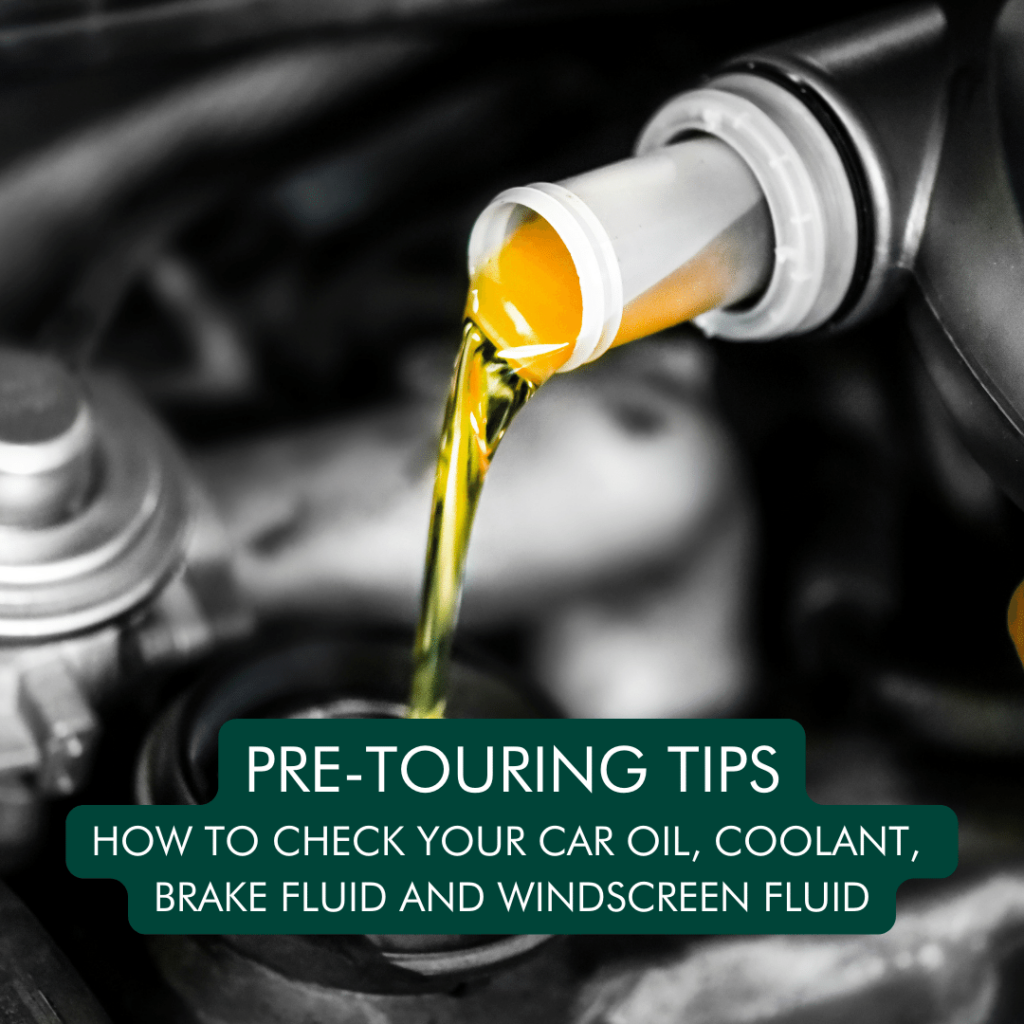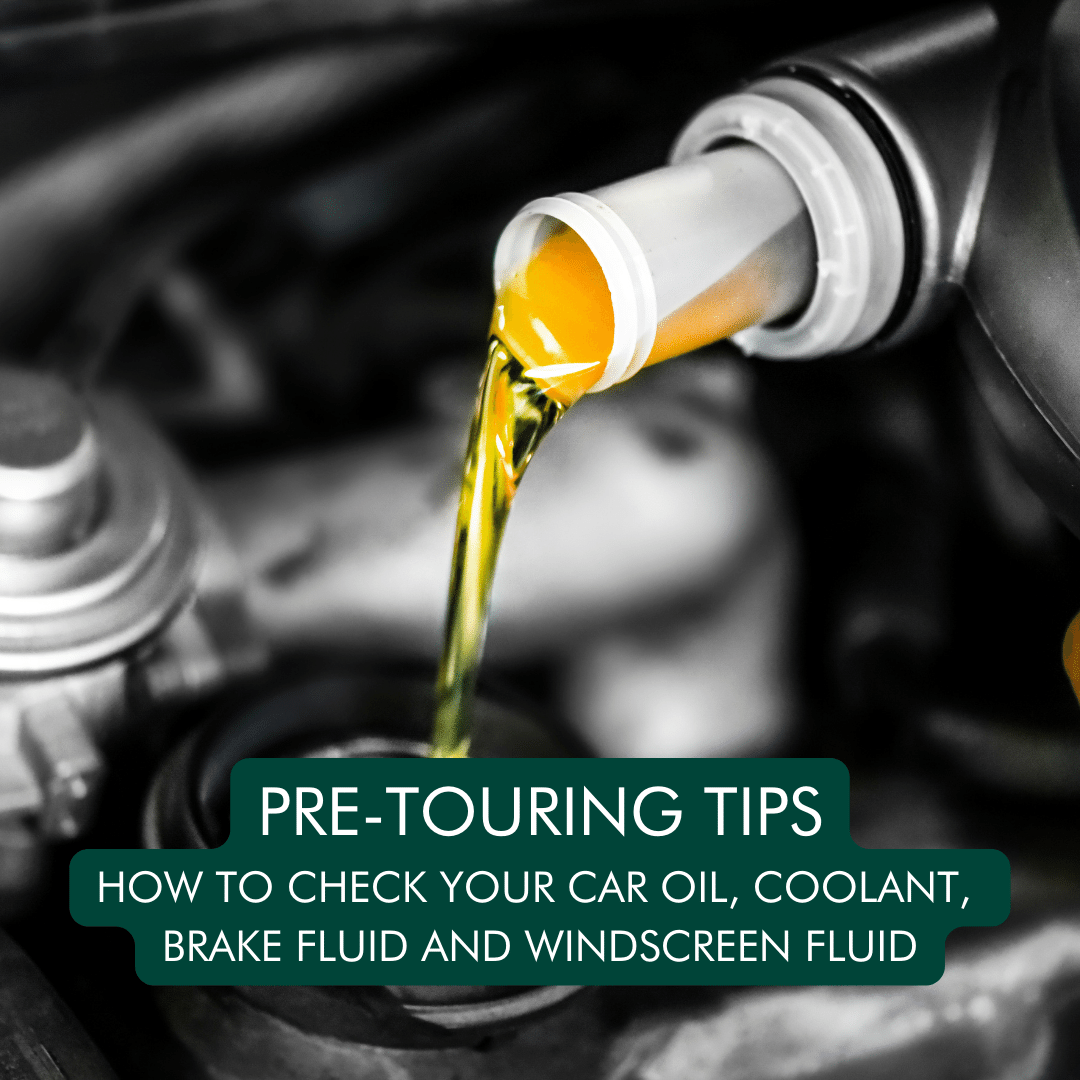Make sure your car is ready for the Spring Getaway
Spring is here and the motoring season is underway and we’ve produced our important Pre-Touring Tips to help prevent any problems during your journeys this Spring and Summer. In this article we look at how to check your Car Oil, Brake and Coolant Levels. If you are planning a road trip or touring in your Aston Martin Car, there are a few things you can do to prepare your car and ensure a smooth journey. In our Pre-Touring Tips, we will discuss some pre-touring preparation tips for your Aston Martin Vehicle to help you have a safe journey and keep your Aston Martin car in the best possible condition for the road and avoid any unwanted car issues.

How to check your Car Oil and top up your Car Oil
It’s important to check your Car Oil on a regular basis and before any long journey. In the video below we demonstrate how to check your Car Oil levels and how to top up the Oil for your Aston Martin Car. At the bottom of this article are videos for different Aston Martin models to further help you.
Step 1: Ensure your Engine is Cool
Firstly, ensure you allow your engine to cool down before checking the Oil in your car and try to park your car on a flat level surface.
Step 2: Locate the Oil Dipstick
Once the engine has cooled down you can open the bonnet and check the oil and if needed top up the Oil. Once the engine has cooled raise the hood (bonnet) of the car and locate the Oil Dipstick. Remove the Dipstick and wipe it with a rag or towel and then reinsert the Dipstick into the Oil Reservoir and remove it again.
Step 3: Identify the current Oil Level
Look at the Oil level on the dipstick and the Oil level should be between the low and max mark.
Step 4: Consider if you need to top up your Oil?
Should the Oil be below the low mark, it is good practise to top up the Oil until it reaches the full mark. If you notice that your Oil level is dropping on a regular basis then your car may have an Oil leak and may need to be inspected by a Garage. Reinsert the Dipstick after.
Step 5: Top up your Oil
Top up the Oil and close the Oil cap firmly.
Can you check your Car Oil Level when the engine is hot and running?
You should wait for the engine to cool and check the Oil levels when the car engine is turned off. By doing this it allows for the Car Oil to collect in the Oil Pan and provide a more accurate Oil Level for you. Also ensure your car is on a flat surface and in a safe and secure place such as a driveway prior to checking your Oil Levels.
Tips for checking your Car oil Levels
It’s important to check the Oil level at least once a month or every 1,000 miles, whichever comes first. If you are driving in dusty or dirty conditions, you may need to check the Oil level more often. Different models will consume different amounts of Oil and overtime your car may leak Oil and thus use more Oil. If your car is using a lot more Oil than usual it’s likely there is an Oil leak and it’s important to get this checked out. Do not overfill the Oil Reservoir as overfilling the Oil can cause leaks and other problems for your car. If you are not comfortable checking your oil, you can take your car to a qualified mechanic to have it checked.
Our Parts team are happy to help you find the right oil for your car model. You can also purchase oil for your car from the Aston Store. Our Service and After Care team can also help should you want a service or oil change.
How to check your car Brake Fluid levels
Once the Car Oil has been checked then the next step is to check the Brake Fluid. Again ensure your car engine has cooled down and is on a flat surface. Brake Fluid should be checked before any long journey or if you notice any issues with your car Brakes. A regular check every month or at least every 3,000 miles is also good practise.
Step 1: Locate the Brake Fluid Reservoir
Locate the brake fluid reservoir under the hood of your car. If you cannot find this watch our videos below.
Step 2: Remove the Brake Fluid Reservoir Cap
The brake fluid reservoir is usually a clear plastic container with a black cap. Remove the cap from the brake fluid reservoir.
Step 3: Inspect the Brake Fluid Levels
Use a flashlight to look inside the reservoir. The brake fluid level should be between the “min” and “max” marks. If the brake fluid level is low,
Step 4: Add any Brake Fluid if needed
If needed add brake fluid until it reaches the “max” mark and then replace the cap and close the reservoir.
Tips for checking your brake fluid
It’s important to check the brake fluid level at least once a month or every 3,000 miles, whichever comes first. Ahead of any planned long touring trip it may also be worth checking to identify any issues before travelling. If you are driving in dusty or dirty conditions, you may need to check the brake fluid level more often. Do not overfill the brake fluid reservoir as overfilling the brake fluid can cause leaks and other problems. If you are not comfortable checking your brake fluid, you can take your car to a qualified mechanic to have it checked.
Signs that you may need to change your brake fluid
Some of the signs and symptoms that may indicate you need to change your cars Brake Fluid can include that the Brake Fluid is dark or has a burnt smell. You may also notice that the Brake Pedal feels spongy or goes to the floor when you press it, suggesting that the Brake Fluid Levels are low. If you notice that your car takes longer than usual to stop or you hear squealing or grinding noises coming from the brakes, it is a good idea to change your brake fluid as soon as possible. Changing your brake fluid regularly can help to keep your brakes working properly and can help to prevent accidents.
How to check your Windscreen Washer Fluid Levels
Windscreen washer fluid helps to remove dirt, bugs, and other debris from your windscreen, which can impair your visibility and make it difficult to drive safely. If your windscreen washer fluid is low, it may not be able to spray evenly on your windscreen, which can leave streaks and smears that can also impair your visibility. In cold weather, windscreen washer fluid can freeze, which can prevent the washer fluid nozzles from working properly. This can leave your windscreen covered in ice, which can make it impossible to see. The washer fluid nozzles can become clogged with dirt and debris if the windscreen washer fluid level is low. This can prevent the nozzles from working properly and may require you to replace them. It is a good idea to check your windscreen washer fluid level every month or every 1,000 miles, whichever comes first. If the level is low, you should add windscreen washer fluid until it reaches the “max” mark. You should also change your windscreen washer fluid every year or every 2,000 miles, whichever comes first.
Step 1: Ensure your engine if turned off
Park your car on a level surface and turn off the engine and ensure the handbrake is on.
Step 2: Locate the Windscreen Washer Fluid Reservoir
Locate the windscreen washer fluid reservoir under the hood of your car. The windscreen washer fluid reservoir is usually a clear plastic container with a blue cap.
Step 3: Check the Fluid Level
Remove the cap from the windscreen washer fluid reservoir and use a flashlight to look inside the reservoir. The windscreen washer fluid level should be between the “min” and “max” marks.
Step 4: Add any Fluid if required
If the windscreen washer fluid level is low, add windscreen washer fluid until it reaches the “max” mark. Replace the cap and close the reservoir.
Tips for checking your windscreen washer fluid
Check the windscreen washer fluid level at least once a month or every 1,000 miles, whichever comes first. If you are driving in dusty or dirty conditions, you may need to check the windscreen washer fluid level more often. Do not overfill the windscreen washer fluid reservoir. Overfilling the windscreen washer fluid can cause leaks and other problems. If you are not comfortable checking your windscreen washer fluid, you can take your car to a qualified mechanic to have it checked.
Signs that you may need to change your windscreen washer fluid
The windscreen washer fluid is dirty or has a foul smell or the windscreen washer fluid is not spraying out of the nozzles. If you notice any of these signs, it is a good idea to change your windscreen washer fluid as soon as possible. Changing your windscreen washer fluid regularly can help to keep your windscreen clean and safe to drive in all weather conditions.
How to check your Car Coolant Levels
Coolant helps to keep your engine cool by absorbing heat and transferring it to the radiator, where it is dissipated. If the coolant level is low, the engine may overheat, which can cause serious damage. Coolant also helps to protect your engine from corrosion by forming a protective layer on the metal surfaces. If the coolant level is low, the engine may be more susceptible to corrosion. Coolant helps to lubricate the seals and gaskets in your car’s cooling system. If the coolant level is low, the seals and gaskets may not be able to do their job properly, which can lead to leaks. Coolant helps to keep your car’s cooling system clean and free of debris. If the coolant level is low, debris can build up in the cooling system, which can damage the system and shorten its lifespan.
It is a good idea to check your car’s coolant levels at least once a month or every 3,000 miles, whichever comes first. If the coolant level is low, you should add coolant until it reaches the “max” mark. You should also change your car’s coolant every 2 years or 30,000 miles, whichever comes first.
Step 1: Ensure your engine is cool
Ensure your car engine has cooled down and is on a flat surface
Step 2: Locate the Coolant Reservoir
Locate the Coolant reservoir under the hood of your car. The coolant reservoir is usually a clear plastic container with a green or orange cap.
Step 3: Check Coolant Level
Remove the cap from the coolant reservoir. Use a flashlight to look inside the reservoir. The coolant level should be between the “min” and “max” marks.
Step 4: Add Coolant if needed
If the coolant level is low add coolant until it reaches the “max” mark. Replace the cap and close the reservoir.
Tips for choosing the right coolant
Choose a coolant that is compatible with your car’s engine. Different engines require different types of coolant. Choose a coolant that is rated for the climate you live in. In the Winter your need to ensure suitable Anti-Freeze is added to the coolant. If you are driving in dusty or dirty conditions, you may need to check the coolant level more often and it’s important to not overfill the coolant reservoir. Overfilling the coolant can cause leaks and other problems. If you are not comfortable checking your coolant, you can take your car to a qualified mechanic to have it checked.
Signs that you may need to change your car coolant
The coolant is dirty or has a burnt smell or the coolant reservoir is leaking. You may also notice the engine is overheating on journey’s or you may even see white smoke coming from the exhaust pipe. If you notice any of these signs, it is a good idea to change your car coolant as soon as possible. Changing your car coolant regularly can help to keep your engine running smoothly and prevent overheating.
Tips for choosing the right coolant
Choose a coolant that is compatible with your car’s engine. Different engines require different types of coolant. Choose a coolant that is rated for the climate you live in. If you live in a cold climate, you will need a coolant that is designed to prevent freezing.
At Nicholas Mee we have created Pre-Touring Tip Videos for each Aston Martin Model
Simply Click on the image to watch the Pre-Touring Tips for each specific Aston Martin Vehicle.
DB4, DB5, DB6 Models Pre Touring Tips here: – Watch the Video here
V8 1980-1990 Models Pre Touring Tips here: – Watch the Video here
DB7 Vantage Model Pre Touring Tips here: – Watch the Video here
V8 Vantage 2005+ Model Pre Touring Tips here: – Watch the Video here
DB9, Rapide, DBS and V12 Vantage Pre Touring Tips here: – Watch the Video here
By following these Pre-Touring Tips, you can help to ensure that your Aston Martin is in good condition and ready for your next touring adventure. If you need any help our Service and After Care Team at Nicholas Mee are happy to help – Visit our page for more information
Should you need help sourcing any parts such as Oil, Anti-Freeze or Brake Fluid – we supply these for Aston Martin models in the Aston Store





